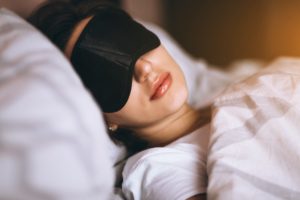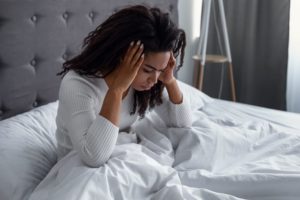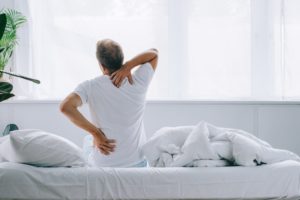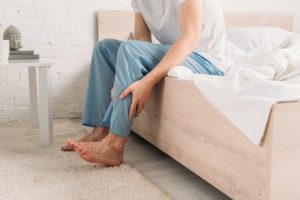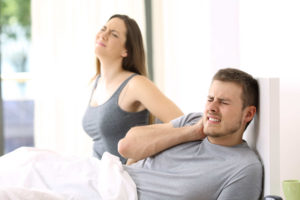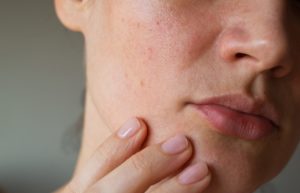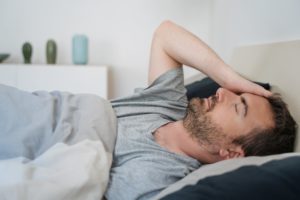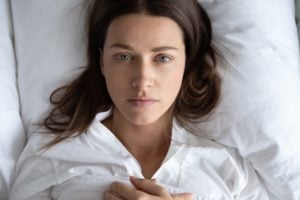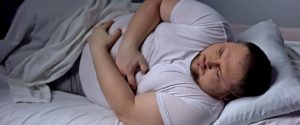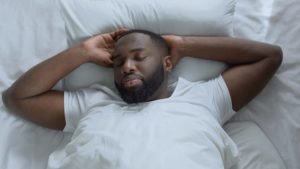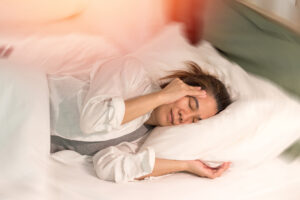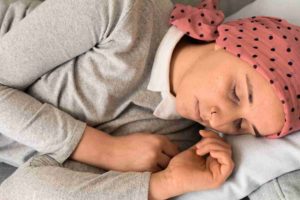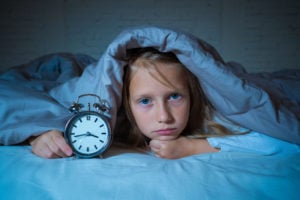Parkinson’s Disease and Sleep
Parkinson’s disease is a complex movement disorder thought to affect as many as 1 million people in the United States. It is more common in older adults, affecting 10 percent of those over 80 years old. While most symptoms can be managed medically, there is currently no known cure.
It’s estimated that two-thirds of those afflicted with Parkinson’s disease struggle to get quality sleep. In fact, sleep problems are increasingly recognized as a potential early indicator of Parkinson’s disease. Sleep disturbances in Parkinson’s patients are contributing risk factors for cognitive decline, and cognitive decline itself is known to exacerbate sleep disturbances.
Why Do Parkinson’s Patients Have Trouble Sleeping?
Despite having daytime tremors, Parkinson’s patients do not shake in their sleep . However, both Parkinson’s disease itself and the medications used to treat it can give rise to a number of sleep problems that lead to insomnia and excessive daytime sleepiness.
Patients with motor symptoms may have trouble adjusting sleeping positions to get comfortable. Others may experience distressing nocturnal hallucinations when trying to fall asleep. These may be a result of medications or cognitive impairment.
In turn, excessive daytime sleepiness (EDS) may occur as a consequence of sleeping poorly at night. It may also be triggered by medications. Parkinson’s patients who suffer from EDS may be at a higher risk of accidents and unable to safely carry out activities such as operating a motor vehicle.
Since insomnia frequently goes hand-in-hand with anxiety and depression , it may be a contributing factor to sleep problems in people with Parkinson’s disease. For that reason, doctors often look for mental health disorders in people with Parkinson’s disease who have sleep problems.

Sleep Disorders Related to Parkinson’s Disease
In addition to other sleep problems, people with Parkinson’s disease appear to be more susceptible to certain sleep conditions:
- Circadian rhythm disruptions: Reduced dopamine may significantly alter the body’s sleep-wake cycle . This disruption of the circadian rhythm may throw off their sleep schedule, giving rise to insomnia and daytime sleepiness.
- REM sleep behavior disorder: REM sleep behavior disorder is one of the most common sleep disorders seen in people with Parkinson’s disease, affecting up to 50 percent of patients . This disorder causes people to act out their dreams, though they are unaware of this behavior. Their physical movements may translate to violent actions such as hitting a sleeping partner. Unlike in sleepwalking, those who suffer from REM sleep behavior disorder usually remember their dreams and describe them as vivid. REM sleep behavior disorder often begins years before Parkinson’s is diagnosed and appears to be a risk factor for more severe cognitive decline.
- Obstructive sleep apnea: People with obstructive sleep apnea (OSA) suffer repeated lapses in breathing that disrupt sleep quality, often accompanied by snoring and gasping. People who suffer from Parkinson’s disease often display upper airway obstruction, restrictive lung disease, and other factors that contribute to a higher chance of developing OSA .
- Restless legs syndrome: Restless legs syndrome is characterized by an irresistible urge to move the legs, especially when at rest. This sleep disorder affects between 30 and 80 percent of people with Parkinson’s disease and often appears very early on in the disease . Some researchers theorize that the co-occurrence of Parkinson’s disease and restless legs syndrome may be related to the body’s lack of dopamine .
- Nocturia: Frequent nighttime urination, or nocturia, affects the vast majority of Parkinson’s patients to some degree. Though not technically a sleep disorder, frequent nighttime urination impairs sleep quality and may result in fragmented, less restorative sleep.
The Relationship Between Parkinson’s Disease and Sleep
It’s unclear whether poor sleep causes parkinsonian symptoms to worsen or whether worsening parkinsonian symptoms cause poor sleep. In many cases it’s likely a case of bidirectionality, with each one exacerbating the other.
Fragmented sleep and sleep deprivation appear to leave the brain more vulnerable to oxidative stress , which has been tied to the development of Parkinson’s disease. Parkinson’s disease is not usually diagnosed until individuals have developed sufficient motor symptoms, by which time a significant portion of brain cells have already been damaged. If poor sleep quality or having sleep disorders foreshadows the development of parkinsonian symptoms , these could be useful in early diagnosis of the disease.
More research is needed to clarify the multifaceted relationship between Parkinson’s disease and sleep. A better understanding of this connection may offer medical experts the unique opportunity to screen at-risk individuals and perhaps delay the onset of the disease.
Diagnosis and Treatment of Parkinson’s Sleep Problems
Parkinson’s disease is chronic and progressive, meaning it tends to get worse over time. However, there are treatment options that can help manage symptoms and allow patients to get more restful sleep.
The simplest way to start sleeping better with Parkinson’s disease is by adopting healthy sleep habits. Sleep hygiene tips for Parkinson’s disease sufferers include:
- Sticking to regular bedtimes
- Following a consistent bedtime routine with soothing activities such as listening to music or reading a calming book
- Getting regular exercise, preferably early in the day
- Getting adequate exposure to light, whether outdoors or through light therapy
- Avoiding long naps and naps late in the day
- Creating a cool, dark, and comfortable sleeping environment
- Restricting bedtime activities to sex and sleep only
- Turning off screens an hour before bedtime
- Reducing liquid intake before bedtime
- Avoiding caffeine, alcohol, and tobacco
- Eating a healthy diet and avoiding large meals at night
Light therapy , exercise , and deep brain stimulation have been successfully used to improve overall sleep quality and to treat specific conditions, such as REM sleep behavior disorder, in patients with Parkinson’s disease. Cognitive behavioral therapy for insomnia (CBT-I) has proven effective at reducing insomnia in healthy adults, although further research is needed on the effects of CBT in patients with Parkinson’s disease.
Patients who suspect their sleep problems may be caused by a sleep disorder should ask their doctor about appropriate testing, such a sleep study known as polysomnography. This is an overnight exam during which multiple sensors monitor sleep stages, eye movements, and other pertinent data to identify sleep disorders.
If a sleep disorder is diagnosed, treating that disorder can help address its potential consequences. For example, in patients with REM sleep behavior disorder, it is important to safety-proof the sleeping environment to avoid harm to the patient or to a sleeping partner that can happen when they act out their dreams. By contrast, a patient with obstructive sleep apnea may elect to use a CPAP machine to encourage uninterrupted breathing while sleeping.
A variety of medications and sleep aids such as melatonin are used to treat sleep-related symptoms of Parkinson’s disease. If you suffer from sleep problems, consult with your doctor before taking any over-the-counter or prescription medications. Your doctor can develop a specially adapted treatment plan to fit your situation. This may mean switching medications, managing doses, altering schedules, or cutting out medications that interfere with sleep.
References
14 Sources
-
National Institute of Neurological Disorders and Stroke. (2020, June 10). Parkinson’s Disease: Hope Through Research., Retrieved September 18, 2020, from
https://www.ninds.nih.gov/Disorders/Patient-Caregiver-Education/Hope-Through-Research/Parkinsons-Disease-Hope-Through-Research -
Kay, D. B., Tanner, J. J., & Bowers, D. (2018). Sleep disturbances and depression severity in patients with Parkinson’s disease. Brain and behavior, 8(6), e00967.
https://pubmed.ncbi.nlm.nih.gov/30106239/ -
Videnovic, A., & Golombek, D. (2013). Circadian and sleep disorders in Parkinson’s disease. Experimental neurology, 243, 45–56.
https://pubmed.ncbi.nlm.nih.gov/22935723/ -
Jozwiak, N., Postuma, R. B., Montplaisir, J., Latreille, V., Panisset, M., Chouinard, S., Bourgouin, P. A., & Gagnon, J. F. (2017). REM Sleep Behavior Disorder and Cognitive Impairment in Parkinson’s Disease. Sleep, 40(8), zsx101.
https://pubmed.ncbi.nlm.nih.gov/28645156/ -
Bargiotas, P., Schuepbach, M. W., & Bassetti, C. L. (2016). Sleep-wake disturbances in the premotor and early stage of Parkinson’s disease. Current opinion in neurology, 29(6), 763–772.
https://journals.lww.com/00019052-201612000-00015 -
Crosta, F., Desideri, G., & Marini, C. (2017). Obstructive sleep apnea syndrome in Parkinson’s disease and other parkinsonisms. Functional neurology, 32(3), 137–141.
https://pubmed.ncbi.nlm.nih.gov/29042002/ -
Alonso-Navarro, H., García-Martín, E., Agúndez, J., & Jiménez-Jiménez, F. J. (2019). Association between restless legs syndrome and other movement disorders. Neurology, 92(20), 948–964.
https://www.neurology.org/lookup/doi/10.1212/WNL.0000000000007500 -
Verbaan, D., van Rooden, S. M., van Hilten, J. J., & Rijsman, R. M. (2010). Prevalence and clinical profile of restless legs syndrome in Parkinson’s disease. Movement disorders : official journal of the Movement Disorder Society, 25(13), 2142–2147.
https://onlinelibrary.wiley.com/doi/10.1002/mds.23241 -
Mantovani, S., Smith, S. S., Gordon, R., & O’Sullivan, J. D. (2018). An overview of sleep and circadian dysfunction in Parkinson’s disease. Journal of sleep research, 27(3), e12673.
https://onlinelibrary.wiley.com/doi/10.1111/jsr.12673 -
Sohail, S., Yu, L., Schneider, J. A., Bennett, D. A., Buchman, A. S., & Lim, A. (2017). Sleep fragmentation and Parkinson’s disease pathology in older adults without Parkinson’s disease. Movement disorders : official journal of the Movement Disorder Society, 32(12), 1729–1737.
https://pubmed.ncbi.nlm.nih.gov/29082554/ -
Lysen, T. S., Darweesh, S., Ikram, M. K., Luik, A. I., & Ikram, M. A. (2019). Sleep and risk of parkinsonism and Parkinson’s disease: a population-based study. Brain : a journal of neurology, 142(7), 2013–2022.
https://pubmed.ncbi.nlm.nih.gov/31038176/ -
Fifel, K., & Videnovic, A. (2018). Light Therapy in Parkinson’s Disease: Towards Mechanism-Based Protocols. Trends in neurosciences, 41(5), 252–254.
https://pubmed.ncbi.nlm.nih.gov/29588060/ -
Reynolds, G. O., Otto, M. W., Ellis, T. D., & Cronin-Golomb, A. (2016). The Therapeutic Potential of Exercise to Improve Mood, Cognition, and Sleep in Parkinson’s Disease. Movement disorders : official journal of the Movement Disorder Society, 31(1), 23–38.
https://pubmed.ncbi.nlm.nih.gov/26715466/ -
Sharma, V. D., Sengupta, S., Chitnis, S., & Amara, A. W. (2018). Deep Brain Stimulation and Sleep-Wake Disturbances in Parkinson Disease: A Review. Frontiers in neurology, 9, 697.
https://pubmed.ncbi.nlm.nih.gov/30210429/











